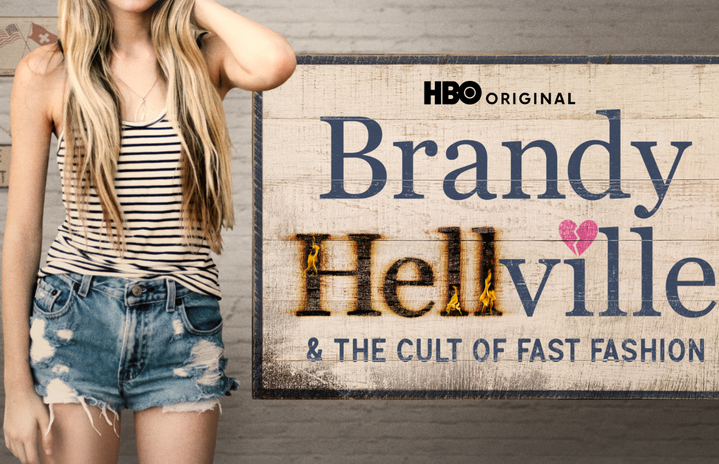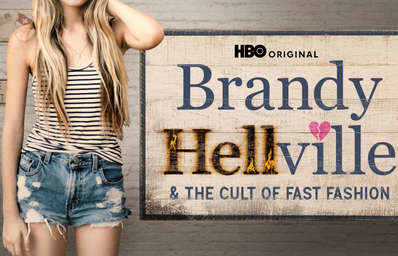Content warning: this article discusses heavy topics such as eating disorders, sexual assault, and racism.
If you were a teenage girl growing up in the 2010s you may be familiar with the popular clothing brand Brandy Melville. Out of nowhere, this brand grew a cult following, and sporting the newest Brandy baby tee became a status symbol for many. Behind the cute dainty tank tops lies a dark backstory that most consumers aren’t aware of. This docuseries does an excellent job of bringing awareness to the shady things the company has done. As well as shining light on the exploitativeness and environmental damage caused by fast fashion brands.
Problematic sizing
I remember ordering my first Brandy Melville top. I was scrolling on Pinterest and came across this baby tee I fell in love with. Then I saw it was from Brandy Melville and immediately thought oh crap, no way is that going to fit me. One of the issues the documentary brings up is the toxic sizing and the lengths people will go to fit into their clothing. In the documentary, they brought in several former employees to speak about their experiences and opinions of Brandy Melville. Isabela recalls:
“Brandy did put me in that mindset where I hated my body. I hated myself. A lot of girls suffered with it, a lot of the girls there, and I’m still recovering… eating disorders are gonna stay with you for a while.“
I found myself relating to this scene quite a bit. I looked back to when I ordered the shirt as an easily influenced teen thinking I’m definitely not as skinny as the girls meant for Brandy, but maybe I could lose a couple of pounds and make it work. So I ordered it, and to my surprise, it fit. As stupid as it sounds, it was almost fulfilling to think wow I actually fit into Brandy Melville. The documentary brings up the toxic fulfillment of being a “cool girl” wearing Brandy bought for teenage girls, and I fell into the trap. Brandy markets their clothing as “one size fits most” but most of their clothing is a size small or extra small. This creates a problem of inclusivity, but besides its problematic sizing, the documentary brings awareness to the racism the brand owner pushes onto his stores.
The poor treatment of people of color
The CEO Stephan Marsan made it clear to store owners that he wanted to be the face of the brand. Blonde skinny and white is described as what the ideal Brandy looks like. The store hires based on looks, an anonymous ex-store owner said:
“There was a quiet non-written agreement where you need good-looking girls at the store… All the guidelines come from Stephan.”
Although there are employees that are people of color, they are usually pushed to the back and in charge of all the “heavier work” like unloading clothes. Another ex-employee Kali recalls that there were no white people in the stock room and “if you’re white, you have to be in sight”. A group chat of Stephan and other Brandy higher-ups was exposed where racist, homophobic, and anti-semitic jokes were shared.
The documentary further elaborates on how fashion companies exploit women, mainly women of color, through abusive situations. In Accra, Ghana about fifteen million clothing items are shipped in for the locals to deal with. Chloe Assam from The Or Foundation discusses how women carry at least 120 pounds worth of clothing bales on the tops of their heads numerous times a day, causing several health issues.
Brandy’s made in Italy tag also deceives consumers into thinking “if it’s made in Italy, that it’s somehow better” according to Ayesha Barenblat, CEO of the Remake Advocacy Group. However, these clothes are made in Prato, Italy where sweatshops exploiting Chinese immigrants is a growing problem. Fast fashion companies have turned to these sweatshops because they know they can get away with cheap labor done quickly compared to other Italian textile companies.
getting away with sexual assault
Willow, an ex-photographer for Brandy, recounts being invited to the Brandy Melville apartment in New York. She assumed she would be the only one staying in the apartment but saw numerous girls walking in and out of the apartment frequently. What shocked her was when an older man who worked for the brand came to stay at the apartment at the same time she was living there:
“It was strange to be living with a man like, in his 30s, 40s, I don’t know how old he was, while I was still, like, a teenager.”
Unfortunately, this is not the worst thing occurring in the Brandy apartment. Kate Taylor, the lead investigator for the series, reported a sexual assault that happened to an employee of one of the New York stores. The victim had been in the United States on a work visa and needed a place to stay temporarily. While staying in the apartment, an Italian middle-aged man unsuspectedly showed up to the apartment. The man offered to take her out to drinks, but the night ended with her being date raped. Taylor elaborates:
“Her hospital records at the time, which I’ve read, says she was raped by her boss, and that she does not want to report it to the police because she does not want to lose her job and be forced out of the country… this was one of the most horrifying things that I heard about while reporting on brandy.”
My final takeaway
Although I had already been aware of Brandy’s various scandals, the biggest shock to me was the pollution on the coast of Ghana due to secondhand clothing. Sara Johnson, writer for The Guardian, reports “[a]s fast fashion grows – cheap clothes bought and cast aside as trends change – has grown, the volume of clothing coming to the market has increased while the quality has gone down”. The United States, the United Kingdom, and China are the major contributors to this problem. Most of the clothing is either burnt or pushed into the gutter system where it will end up flooding the shores of Accra. The footage shown in the docuseries of the shores filled with clothing is concerning. When samples of water were tested there were a shocking amount of microfibers. This quote, by Sammy Oteng, was particularly impactful to me:
“We are a part of the problem no matter where you live in the world. The fact that it’s not in your backyard does not mean it’s not your problem.”
So maybe we as consumers should start being more mindful of the brands we are supporting, and tackle the growing issue of fast fashion before it becomes too late.


